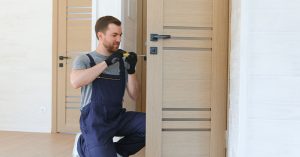Selecting a new garage door can feel overwhelming. There are styles, materials, and features to consider, all while keeping Calgary’s climate in mind. We understand that a garage door isn’t just a decorative feature, it protects your home, improves energy efficiency, and adds value. Let’s look at what matters most when choosing the right door for your home, step by step, with practical advice based on what actually works in Calgary homes.
Understanding Calgary’s Climate and Its Impact
Calgary’s weather brings warm summers, freezing winters, and sudden temperature swings. These changes can affect how a garage door performs. Choosing a door that handles moisture, wind, and extreme cold is essential. Insulation plays a big role in this decision.
An insulated door reduces heat loss and keeps garages warmer in winter. It also minimizes noise and prevents cold drafts from reaching inside living spaces. We often recommend checking the R-value of any door you consider. A higher R-value means better insulation and more energy savings. Homeowners who park vehicles or use the garage as a workspace notice a big difference in comfort.
Materials also react differently to weather. Steel is durable but can dent. Wood looks beautiful but needs regular care. Aluminum resists rust but conducts cold easily. Taking time to match the material to your home’s environment saves long-term repair costs.
Choosing the Right Material for Durability and Style
Garage doors come in several main materials: steel, wood, aluminum, fiberglass, and composite. Each has unique strengths and drawbacks.
Steel doors are popular because they balance strength, cost, and design flexibility. They can be single or double layered, with or without insulation. We’ve seen many homeowners choose steel doors for their ability to resist Calgary’s wind and snow. However, even a small dent can show, so consider textured finishes to disguise wear.
Wood doors bring a warm, classic appearance. They’re perfect for traditional homes or craftsman-style exteriors. The main drawback is maintenance. Moisture and cold weather can warp wood, so regular sealing and painting are essential.
Aluminum doors are lightweight and modern-looking. They often feature glass panels, which make them ideal for contemporary homes. The downside is that aluminum transfers cold easily, so insulation becomes more important. Composite materials offer a middle ground—they mimic wood’s look but require less maintenance.
Fiberglass is less common but works well if you want a corrosion-resistant option. However, it can crack in extreme cold, which makes it less suited for long Calgary winters.
For examples of local installation options, you can explore styles and insulation levels available for a garage door in Calgary that matches your home’s needs and weather conditions.
Considering Insulation and Energy Efficiency
Insulated garage doors make a noticeable difference in how your home feels. Even if the garage isn’t heated, insulation helps reduce energy loss from adjacent rooms. Calgary homeowners often underestimate how much heat escapes through uninsulated doors.
There are two main insulation types: polystyrene and polyurethane. Polystyrene panels are similar to foam boards and are more affordable. Polyurethane, on the other hand, is injected into the door, expanding to fill gaps. It offers superior thermal protection and soundproofing.
When comparing models, check both the R-value and the door’s sealing features. Look for bottom seals, weather stripping, and thermal breaks to stop drafts. An insulated door can also make the garage quieter by dampening outside noise. This is especially useful in busy neighborhoods or homes near main roads.
If your garage connects directly to your living space, an insulated model is worth the investment. It not only improves comfort but also lowers energy costs throughout the year.
Matching the Door Style to Your Home’s Architecture
Style is more than color or design—it affects your home’s overall balance and curb appeal. Modern doors use clean lines and glass panels to match minimalist architecture. Traditional homes often suit carriage-style or raised-panel doors that echo classic design.
Color plays a big role too. Light colors reflect heat but can show dirt faster. Dark colors absorb warmth, which may help reduce frost buildup on sunny winter days. However, darker finishes can fade more quickly in direct sunlight. Neutral tones like taupe, white, and gray stay popular because they fit most exterior designs.
Windows are another feature to consider. They bring natural light into the garage and enhance the home’s exterior. Frosted or tinted glass protects privacy while still letting in light. Placement also matters, top-section windows add brightness without compromising security.
We always suggest imagining how the new door will look with the rest of the property, including trim, siding, and driveway layout. A well-chosen door complements the home instead of standing out awkwardly.
Balancing Cost, Features, and Long-Term Value
A garage door is an investment that lasts for years. Price varies by size, insulation, material, and hardware. While it’s tempting to focus on the lowest cost, cheap doors often lead to higher repair and replacement expenses later.
Steel doors with good insulation offer the best overall value for most Calgary homes. They’re cost-effective, low-maintenance, and suitable for harsh winters. If you plan to stay in your home for many years, choosing a mid-range or premium model pays off through energy savings and fewer service calls.
Don’t overlook warranties and part availability. A strong warranty shows confidence in product quality. Reliable access to replacement parts ensures smoother maintenance over time. Checking these details before purchase helps avoid frustration later.
Finally, safety features like pinch-resistant panels, tamper-resistant brackets, and auto-reverse sensors protect both family and property. Modern doors with improved balance systems also reduce strain on openers, extending their lifespan.
Installation Quality and Professional Setup
Even the best door won’t perform well if installed incorrectly. Proper alignment, tensioning, and sealing all affect function and durability. A misaligned track or uneven spring tension can make the opener strain, shorten part life, and cause noisy operation.
We often see issues caused by rushed installations or uneven foundations. A professional technician measures, levels, and seals the door for optimal performance. They also ensure that safety sensors and opener systems are calibrated properly.
A key tip is to schedule installation during mild weather whenever possible. It helps materials expand evenly, allowing for more accurate fitting. After installation, ask for a walkthrough of how to operate and maintain the door safely. Learning how to test the auto-reverse feature and lubricate moving parts keeps the system reliable for years.
If you’re considering replacing or upgrading your current system, you can always contact us for advice on the best type of garage door suited to your home and local weather.
Maintenance Tips to Extend the Door’s Life
Maintenance is what keeps a garage door running smoothly year after year. Regular checks help prevent small issues from turning into major repairs. Once every few months, inspect the rollers, hinges, and tracks for wear. Lubricate moving parts with a silicone-based spray to reduce friction and noise.
Cleaning is also important. Dust and debris build up along the tracks, affecting movement. Washing the exterior once or twice a year prevents corrosion, especially on metal surfaces. If the door has weather stripping, check it for cracks or stiffness. Replacing worn seals keeps drafts and water out.
We also recommend testing the balance. Disconnect the opener and manually lift the door halfway. If it doesn’t stay in place, the springs may need adjustment. Avoid trying to fix high-tension springs yourself, as they can be dangerous without the right tools.
A short maintenance routine not only extends the door’s lifespan but also keeps it looking new. Homeowners who invest a little time in upkeep often save hundreds in service costs.
Smart Technology and Modern Features
Today’s garage doors can do more than open and close. Smart openers connect to mobile apps, letting homeowners control access remotely. This is helpful for deliveries or letting in family members without handing out keys. Some systems even send alerts when the door is left open, improving home security.
Other innovations include battery backups, which keep the door working during power outages, and motion-activated lighting that improves visibility. Homeowners who travel often or work unpredictable hours find these features especially useful.
If upgrading technology isn’t the goal, consider adding a better seal or insulation kit instead. Both small improvements make a big difference in energy savings and comfort without needing to replace the entire door.
Common Mistakes to Avoid When Buying a Garage Door
Homeowners sometimes choose doors based only on appearance or price. While both matter, function and long-term durability are equally important. Another common mistake is not matching insulation levels to garage use. For example, if you store tools, a car, or sports equipment, an insulated door helps protect everything from Calgary’s cold.
Ignoring professional installation is another issue. DIY setups often miss critical alignment or tension adjustments. That can lead to noise, uneven operation, or early spring failure.
Finally, some homeowners skip maintenance until something breaks. Regular care is much cheaper than emergency repairs. Keeping a maintenance checklist on hand makes it easier to stay on top of seasonal upkeep.
FAQs
1. How often should I service my garage door?
Once a year is usually enough. Regular checks keep parts lubricated, springs balanced, and seals tight.
2. Can I paint my garage door to match my house?
Yes, most steel and wooden doors can be painted. Use weather-resistant paint for durability.
3. What is the best material for cold climates like Calgary?
Insulated steel or composite doors perform best in freezing temperatures. They resist warping and reduce heat loss.
4. Are smart garage door openers safe?
Yes, modern systems use encryption and alerts to improve security. Always set strong passwords and update firmware.
5. How long does a typical garage door last?
With proper care, most doors last 15 to 30 years. Material, usage, and maintenance determine the exact lifespan.



